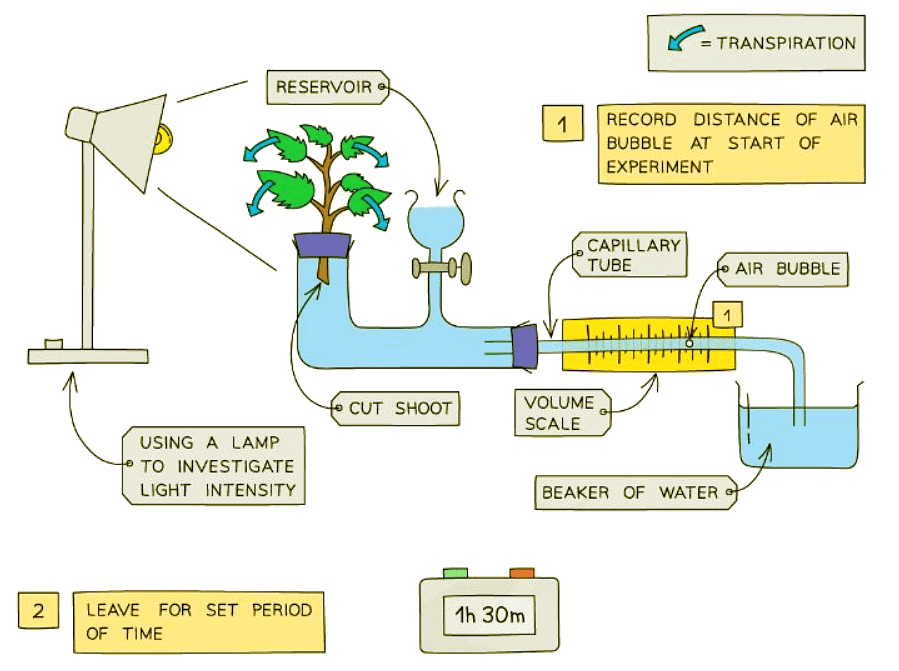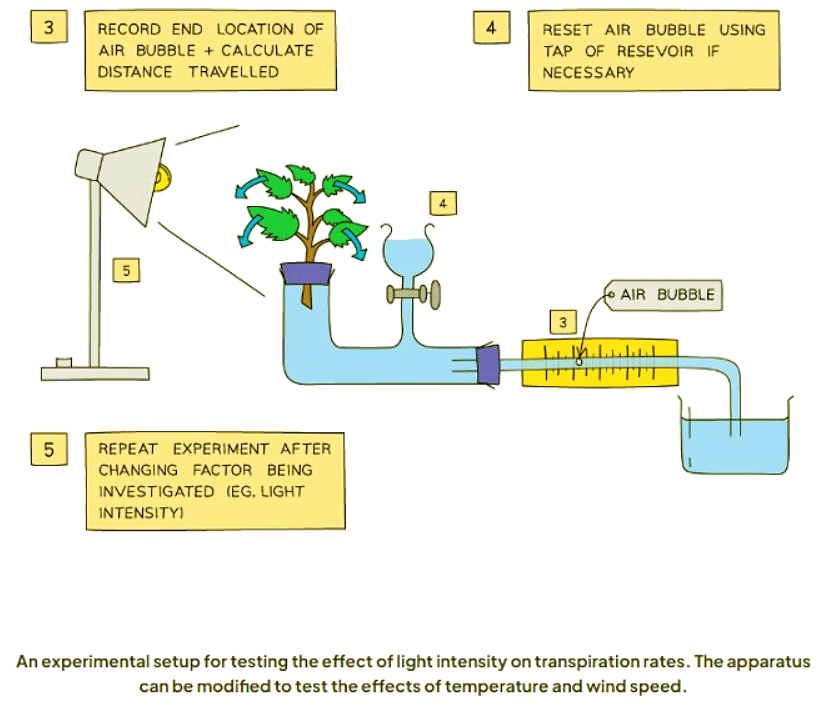Class 10 Exam > Class 10 Notes > Biology for GCSE/IGCSE > Temperature & Wind Speed
Temperature & Wind Speed | Biology for GCSE/IGCSE - Class 10 PDF Download
Investigating the Effect of Temperature & Wind Speed on Transpiration Rate
Investigating the role of environmental factors in determining the rate of transpiration from a leafy shoot:
- Cut a shoot underwater to prevent air entering the xylem and place it in a tube.
- Assemble the apparatus according to the diagram, ensuring it is airtight by using vaseline to seal any gaps.
- Ensure the leaves of the shoot are dry, as wet leaves could affect the results.
- Remove the capillary tube from the water beaker to allow a single air bubble to form, then place the tube back into the water.
- Set up the environmental factor being investigated.
- Allow the plant to acclimatize to the new conditions for 5 minutes.
- Record the initial position of the air bubble.
- Let the setup sit for a specific duration.
- Record the final position of the air bubble.
- Adjust either the wind speed or temperature (only one variable at a time, depending on the investigation).
- Reset the bubble by opening the tap under the reservoir.
- Repeat the experiment.
- The greater the distance the bubble travels in the same time frame, the higher the rate of transpiration; conversely, a shorter distance indicates slower transpiration.


- Environmental factors can be investigated in the following ways:
- Temperature: Room Temperature (Cold and Warm Settings)
- Higher temperatures lead to increased transpiration rates.
- Wind Speed: Utilize an electric fan to simulate varying wind speeds.
- Higher wind speeds correspond to increased rates of transpiration.
- Temperature: Room Temperature (Cold and Warm Settings)
Question for Temperature & Wind SpeedTry yourself: What is the purpose of cutting a shoot underwater and placing it in a tube in the experiment?View Solution
The document Temperature & Wind Speed | Biology for GCSE/IGCSE - Class 10 is a part of the Class 10 Course Biology for GCSE/IGCSE.
All you need of Class 10 at this link: Class 10
|
101 videos|193 docs|33 tests
|
FAQs on Temperature & Wind Speed - Biology for GCSE/IGCSE - Class 10
| 1. How does temperature affect transpiration rate? |  |
Ans. Temperature affects transpiration rate by increasing the rate at which water evaporates from the leaves. As temperature rises, the water molecules inside the plant evaporate more quickly, leading to a higher transpiration rate.
| 2. What is the role of wind speed in transpiration? |  |
Ans. Wind speed affects transpiration by increasing the rate of evaporation of water from the leaf surface. When there is a higher wind speed, the water vapor surrounding the leaf is carried away more quickly, allowing for more efficient transpiration.
| 3. How can the effect of temperature and wind speed on transpiration rate be investigated using a potometer? |  |
Ans. A potometer is a device used to measure the rate of water uptake by a plant. By controlling the temperature and wind speed around the plant, the potometer can be used to observe how these factors influence the rate of transpiration.
| 4. Are there any other factors besides temperature and wind speed that can affect transpiration rate? |  |
Ans. Yes, factors such as humidity, light intensity, and soil moisture levels can also influence transpiration rate. Higher humidity levels can reduce transpiration, while intense light can increase it.
| 5. How does understanding the factors affecting transpiration rate benefit the study of plant physiology? |  |
Ans. Understanding the factors that affect transpiration rate can provide valuable insights into how plants regulate water loss and maintain water balance. This knowledge is essential for understanding plant adaptation to different environmental conditions and for optimizing crop production.
Related Searches















